| FAQ |
Introduction
- Pearson, as an awarding organisation, is required to moderate the marks submitted by centres for any internally assessed components. This requirement is covered in section H2 of Ofqual's General Conditions of Recognition.
- In most centre-assessed components, a sample of work from each centre is provided to a moderator. This can be done through digital submission or a centre visit
- The primary role of the moderator is to report on a centre's interpretation of the published assessment criteria and to compare their marks (referred to as moderator marks) with the original centre marks.
- Depending on the variance between the centre marks and the moderator marks, centres can review on Results Day whether their marking in a particular component was accepted without change or whether adjustments were made.
- This moderation process is a vital part of the awarding process. It ensures all learners are treated fairly by being judged against the same standard.
- Any adjustments made to the centre marks are necessary to bring centres' judgements in line with the national standard.
|
|
Sampling
- Within the centre cohort, it is not always possible to submit work covering all learners for moderation.
- Centres are asked to provide a sample of work for some learners instead.
- The sample is used as a representative of the marking standard within the centre.
- The sample helps to determine whether a teacher-assessor(s) is marking learners at the required standard, against the published assessment criteria.
- We do not change the marks solely for individuals or the sampled learners as part of the moderation process.
- The sample is used to indicate whether (if any) adjustment is necessary for the centre as a whole.
- The sample also helps to determine the size and scale of the adjustment that needs to be applied.
The size of the sample required is determined by the size of the cohort entered for the component at the centre:
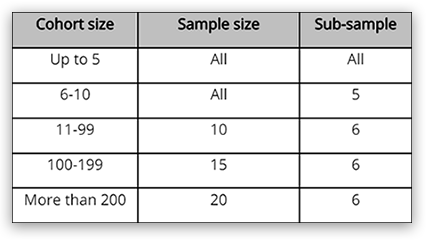
- The sample is selected randomly but should generally consist of work from learners with a range of marks, including the highest and lowest scoring work in the cohort.
- For further information on the NEA submission, you can visit the NEA mark submission webpage.
- Once the sample of work is submitted, the moderator will first look at part of the sample, known as the sub-sample.
- If the moderator agrees with the centre's marks, within the specified variation, for all the work in the sub-sample, then no further work is to be moderated.
- This means that no change is made to the centre's marks, resulting in centre marks being used as the final marks for each learner in a particular component, for results issued.
- However, if the moderator finds that any of the marks in the sub-sample to be outside of the specified tolerance, then they would be required to moderate the rest of the work in the full sample.
- After moderating the full sample, adjustments to the centre's marks may be made using the regression method outlined in the document.
- In most cases the initial sample of work will be sufficient to determine the size and scale of the adjustment that needs to be applied.
- However, in exceptional circumstances where an adjustment cannot be calculated fairly from the sample, due to an extreme range in outcomes where centre marks are found to be inconsistent throughout the samples, the moderator will request additional work to be submitted (often the work of all learners) from the centre.
- This may be necessary to apply a fair adjustment to the marks in the whole cohort. Centres will usually be notified by Pearson if all work is required to be submitted for all learners.
|
|
Tolerance
- When centres' marking is moderated, it is not always possible that each of the sampled work will be in precise agreement.
- It is not reasonable to expect two individuals assessing the same piece of work to make exactly the same judgement, in all marking decisions.
- Therefore, some leeway is necessary to account for these differences in any centre-assessed component; this is called tolerance.
- Tolerance is a fixed number of marks, specific to each component.
- It is used to determine the differences between a centre marking and a moderator marking that can be taken as a legitimate variation in judgement.
- Tolerance is also used to confirm if the centre's marks can be accepted.
- If the differences are outside the specified tolerance, an adjustment to the centre marking will be made.
- This adjustment is made to bring the centre's standard of marking in line with the national standard.
|
|
Example/Scenario
|
Below is a simple illustration displaying how the sample and its tolerance works (described above) for a centre-assessed component (the exampled tolerance is -/+ 2):
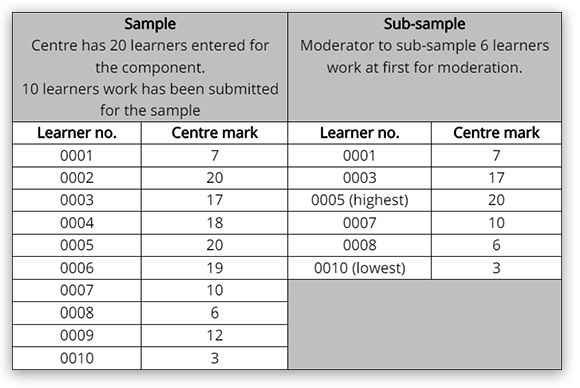
Below is a version where the outcome of the sub-sampling is within the specified tolerance, therefore no further moderation is needed:
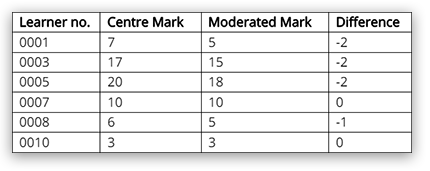
Below is a version where the outcome of the sub-sampling is outside the specified tolerance, therefore further moderation needed i.e. moderate the remaining four pieces of work in the sample:
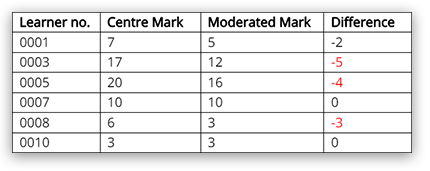
The full sample moderated results (below) remained outside of the +/-2 tolerance limit and therefore a regression is required.
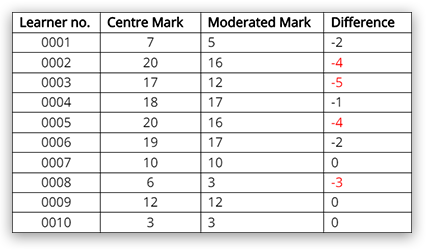
|
|
The regression process - calculating adjustments
- The regression process is a mathematical method used to calculate adjusted marks for learners within a centre
- Regression compares two sets of data, centre marks and moderated marks, to find a relationship and create the most appropriate final marks for all learners.
- A graph can be used to demonstrate the regression process, showing centre marks and moderated marks for learners in a sample.
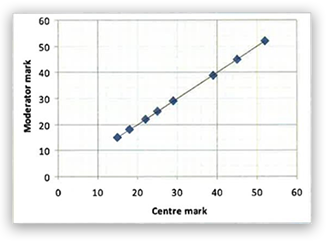
- The regression line, or "line of best fit", is used to calculate an adjusted mark for each learner.
- In most cases, moderation produces data that is closely aligned with the Graph below; where points do not lie precisely in a straight line, but there is a trend and a "line of best fit" can be drawn. This line is known as the regression line:
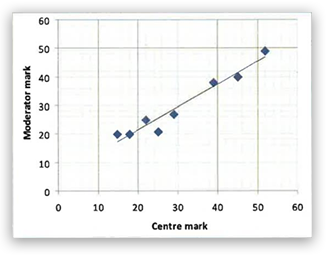
- The regression line, or "line of best fit", is used to calculate an adjusted mark for each learner.
- Pearson computer software calculates these adjusted marks to align them with national standards. The adjustments are then checked by a member of the subject team for errors.
- Adjusted marks can be higher or lower than the centre's marks for some learners, depending on the line of best fit.
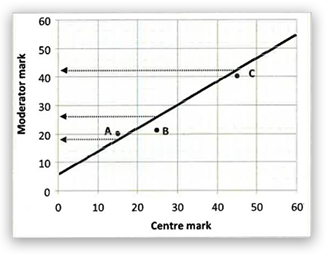
- The intention of the regression process is to use the moderator's marks to calculate an adjusted mark for each learner at a centre, ensuring a fair adjustment for the entire cohort.
- The centre's rank order of learners is maintained, meaning the highest and lowest marks given by the centre will remain the highest and lowest after adjustment:

Candidate A, for example, was given a mark of 15 by the centre, and would receive an adjusted mark of 18. Candidate B was given 25 marks by the centre and the adjusted mark would be 26. Candidate C was given 45 marks by the centre and the adjusted mark would be 42. These marks are adjusted, using the regression line, to 18, 26 and 42 respectively, as shown by the dotted lines.
As in the example above, moderators may give marks that are higher than the centre's marks for some learners, and lower for others. The adjusted marks can fall within that range (i.e. between the centre's mark and the moderator's mark), as well as above it and below it. When looking at individual learners, some appear to 'benefit' from the adjustment (see Learner B in the example who was given a mark of 25 by the centre, 21 by the moderator, and 26 in the adjustment). Conversely, some learners seem to 'lose out' and receive a mark lower than both the centre and moderator gave. This is due to the line of best fit being applied.
- If there is significant disagreement between the moderator and the centre's rank ordering, the recommended adjusted marks may not be accepted and further moderation may be required.
|
|
Results
|
It is important to remember that this is a moderation process and not a marking process as only a sample are reviewed by a moderator. Therefore, when you receive your results we do not provide the moderators marks for the sample, we only provide the final marks for all candidates.
If your cohort has been regressed then these final marks will be the outcome of the regression calculation. A written explanation relating to the findings of the moderator will be found in the moderators report.
|
|
Summary
|
There are four possible outcomes of the moderation process:
- There is no difference between the centre's marks and the moderator's marks for the sampled learners, so the centre's marks are accepted as final marks for all learners in the cohort.
- There are only small differences between the centre's marks and the moderator's marks for the sampled learners, also known as within tolerance, so the centre's marks are accepted as final marks for all learners in the cohort.
- There are greater differences between the centre's marks and the moderator's marks for the sampled learners, but the moderator generally agrees with the centre's rank ordering of the learners, so the regression process described above is used to adjust the marks of all learners in the cohort.
- There is significant disagreement between the moderator and the centre's rank ordering of the learners so further work is moderated before learners' final marks are calculated. In extreme cases this may lead to the moderator's marks being imposed for all learners in the cohort. Remember: adjustments are only made when necessary to maintain equity between centres and candidates. For more information and guidance, visit the dedicated webpage Coursework, controlled assessment and non-exam assessment (NEA).
Remember: adjustments are only made when necessary to maintain equity between centres and candidates.
For a more detailed explanation of this process, please see the PDF: Coursework Moderation of Internal Components and Mark Adjustments.
For more information and guidance, visit the dedicated webpage Coursework, controlled assessment and non-exam assessment (NEA).
|
|
Back to Coursework / Non-Examined Assessments (NEA) index. |
|
|---|



